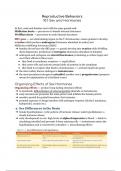Reproductive Behaviors
10.1 Sex and Hormones
At first, male and females start with the same gonads and:
Müllerian ducts → precursors to female internal structures
Wolffian ducts → precursors to male internal structures
SRY gene → sex-determining region on the Y chromosome; causes gonads to develop
in testes which produce androgens (hormones abundant in males) and
Müllerian-inhibiting hormones (MIH)
➔ females do not have the SRY gene => gonads develop into ovaries while Wolffian
ducts degenerate; production of estrogens (hormones abundant in females)
➔ androgens and estrogens are steroid hormones (containing 4 carbon rings) and
exert their effects in three ways:
● they bind to membrane receptors => rapid effects
● they enter cells and activate certain kinds of proteins in the cytoplasm
● they bind to receptors that bind to chromosomes => activate/inactivate genes
➔ the most widely known androgen is testosterone
➔ the most prominent estrogen is estradiol; another one is progesterone (prepares
uterus for implantation of a fertilized ovum)
Organizing Effects of Sex Hormones
Organizing effects → produce long-lasting structural effects
➔ in mammals, differentiation of external genitals depends on testosterone
➔ early testosterone promotes the male pattern and inhibits the female pattern
➔ sensitive period for genital formation: first trimester
➔ prenatal exposure to drugs interfere with androgen response (alcohol, marijuana,
haloperidol, cocaine etc.)
a. Sex Differences in the Brain
➔ female hypothalamus: cyclic pattern of hormone release; male hypothalamus: a
steady hormone release
➔ early development in rats: high levels of alpha-fetoprotein in blood → binds to
circulating estradiol and prevents it from entering cells → testosterone enters the
hypothalamus and is converted to estradiol => masculinizing effects





